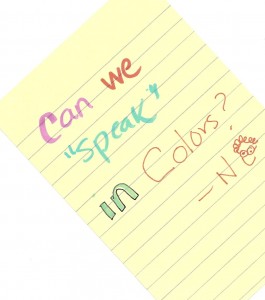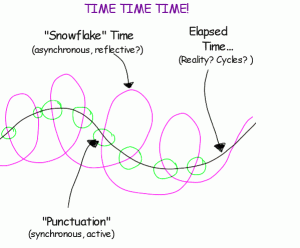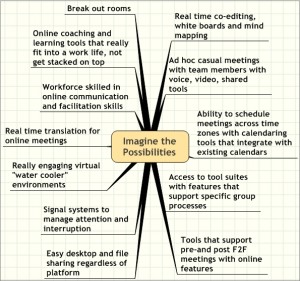Category: learning
eDayz 09 – Rocking in Adelaide
Something about the learning folks in Adelaide just lights me up from the inside out. It was a pleasure to be able to be part of the EDayz09 conference were many of the people I met during my tour in 2006 were present. You know its going to be fun.
Thursday Michael Coghlan met me at the airport (how FUN is it when a real person meets you AT THE GATE these days! Shocking and wonderful) then trundled me into town and dinner with Brad Beach and John (whose last name seems to evade me – so sorry John!) where we had some great S. Australian wine fueled conversations that helped me prepare and contextualise for the next day’s keynote.
 Friday it was off to E-Dayz where I was going to use the springboard question “Should we be using community in learning anymore?” into an exploration of the continuum of me, we and the network as an essential bed for both social and situated learning. The venue was a big, steeply raked theatre style and I felt I should sing and dance. Literally! But I controlled myself. The slides are below, audio is here and video here. Kerry Johnson did an amazing job live streaming the entire event and will get us the video URL
Friday it was off to E-Dayz where I was going to use the springboard question “Should we be using community in learning anymore?” into an exploration of the continuum of me, we and the network as an essential bed for both social and situated learning. The venue was a big, steeply raked theatre style and I felt I should sing and dance. Literally! But I controlled myself. The slides are below, audio is here and video here. Kerry Johnson did an amazing job live streaming the entire event and will get us the video URL
In the afternoon I ran a much more informal workshop, originally intended as follow up from the keynote, but when we started, I made a couple of offers for options, one of which was to explore the role of visuals in our work. We did Johnnie Moore’s paired drawing exercise and I then gave the option on topics. MORE VISUALS. This went on for the full 40 minutes and I was so grateful to be able to play in that space as we looked at specific applications of the use of visuals in online learning.
All in all it was a great day. There is so much more I could write, but the days are flying and I need to get this posted. Darn, tho I missed talking with Graham Wegner, whom I’ve followed on Twitter for some time!
Johnnie Moore, Monoliths and Individuals
 Johnnie Moore’s Weblog: The genie out of the bottle
Johnnie Moore’s Weblog: The genie out of the bottle
All this inventive technology is being made available to just about anyone with a web connection.
How does it compare for engagement and collaboration with anything inside the firewall of organisations? I’ve argued before that, over the last few years, the technological advantage has shifted massively away from companies to individuals. I think we may only have scratched the surface of the impact this will have.
Yesterday I was talking to a potential collaborator who has some business inside of a big company. I usually work in the non profit sector, but this bit sounded interesting, I liked the potential colalborators’ expressed values so we are continuing the conversation. There was one bit that really struck me… a comment about their resiliience in dealing with slow moving, often self-contradicting companies.
My response was that I cope with the frustration and discouragement of working with monolithic organizations by focusing on the potential, possibilities and the growth that happens within individuals. Eventually these individuals influence their organizations, or they leave. It is potentially quite subversive. Change or lose your best talent.
Seriously, I need to write up my triangulation thoughts. This is relevant and is giving me a new frame to understand and talk about my work. But it is month end. Billing and Austraila prep rule the day!
Photo Credit: Creative Commons picture on Flickr from ElDave. Thanks!
FLNW09: What do we owe our networks?
 Warning: long, rambly post that is more for the FLNW network than many of you, dear readers. But it is something I owe, and because of the nature of the network, I owe it publicly. This is not mine to hold close in an email thread.
Warning: long, rambly post that is more for the FLNW network than many of you, dear readers. But it is something I owe, and because of the nature of the network, I owe it publicly. This is not mine to hold close in an email thread.
I was hugely appreciative that Michael Coglan, Robyn Jay and Stephan Ridgway took some time to make a podcast with Michael about the August FLNW (Future of Learning in a Networked World) road trip here in the Pacific Northwest of the US. It put an item that had been languishing on my to do list higher in the queue – blog about the week. I did a quick post while on the road, but it took all my attention to keep the logistical wheels on the road trip “bus” (my minivan and Sylvia’s SUV), plus I had just gotten over a bug that I now think may have been a mild case of the H1N1 viruas. Go figure!
Anyway, the podcast and rereading this thread from our email list has me trying again to express what I learned and what I am still feeling. So much of that learning is still half cooked. I don’t know if I can even express it at all. Some of it is intellectual. Some emotional and some may be or should be more private and personal. Oh well… worth a try.
I had a wonderful time with Sylvia Currie, Leigh Blackall, Derek Chirnside, Sunshine Connelly, and Michael Coghlan, and loved, as always, the beauty of my region. We traveled in two vehicles, me meeting the gang rolling down from Vancouver B C after the Open Ed conference. We hooked up in Mount Vernon, Washington, made the mad dash to the ferry on Whidbey Island to Port Townsend (after missing our reservation time… we were one of the last on a much later ferry!), and stopping the first night in Port Angeles. From there we went on to Forks and finally, Menlo, Washington, ending up in Seattle. You can see the travel bits on the wiki and Flickr pictures.
Somehow, I want to share what I learned from our conversations about learning in a networked world and what I continue to learn about group process in this little groups process (or sometimes lack of process!) It is in the latter that I’m still muddling and a bit uncomfortable. So I’ll start with the uncomfortable.
After listening to the podcast, particularly the observations and questions of Robyn and Stephan, i took time to comment. My comments on the podcast post start to surface my concerns and complicity. This was my very long comment on the podcast. Yeah, rambly. But I warned you, right?
Thank you so much for making and sharing this conversation. I’m in the midst of writing up a long-overdue blog post. This helps urge me forward. I have been resisting because I have some conflicting feelings and am concerned about how I express them – because they are all double edged swords. How much sweetness, how much sting and how much time to thoughtfully and honestly express both. I also realized that so many of our conversations were quite personal, and I have been cogitating on how to transfer the learnings of those conversations without trespassing on the beauty of some of the personal nature of the conversations and what should be maintained in that boundary. It takes a lot of time. I’ve been avoiding it.
First, it was pretty heartbreaking to hear the disappointment. Because I personally feel I let you down, and also because I share some of that disappointment. So the combo of responsibility, guilt … haha. You know how much fun that is!
At the same time, I don’t want to let that disappointment diminish the quality of the time together for those of us on the road. So there are clearly conflicting feelings in me.
I want to add one part here very specific around the end of the podcast around roles, responsibilities and decisions. Michael said Sylvia and I didn’t mind making the decisions etc.
I’d like to express that it was uncomfortable and at times I did mind. And certainly I worried about it. I felt I prodded and prodded with little response from the group, but Sylvia and I were the newbies in the group. Maybe we didn’t know something they experienced guys knew, eh? I can be a very pushy and action oriented person by nature. I was trying to be very careful not to “drive” things (and annoy the crap out of everyone!) Believe me, I can annoy the crap out of everyone. I have been given specific feedback from dear and close friends that I can also “take up too much space” in conversations etc. There were certainly moments where I was aware of this. (I;m writing this with a smile. I am hoping the others in the group read this with a smile!)
In July I told Sylvia I was concerned. I thought the rest of the gang were not concerned about substance or focus beyond Derek, and he let that go (I’m guessing because no one else took him up on his ideas?). Why were no other folks wanting to join in? Was the “sustainability” theme just hot air? There seemed to be little engagement. It was “we’ll show up and it will happen. ” OK. that was not what I thought FLNW was about.
At some point I was chafing because I didn’t want to be just a tour guide and I *did* want to be a host of a learning adventure/journey/conversations. I felt quite odd making so many decisions because, while local knowledge helps inform options, it does not privilege decision making. I was truly happy to facilitate the logistics and help provide the transportation. Absolutely. But what about the ‘heart” of things? How would that happen?
I did not express that well, if at all. This is the sad sign of a facilitator facilitating facilitators. I said at one point to Michael that this is always a bad combo! LOL. We tend to ignore our own advice.
At that point, I made the personal decision to simply go with the flow. If there was no energy to plan, act, lead, decide, then it would happen as it would happen. Getting sick the week before only solidified my approach. There was literally no energy available.
This was an essential key for me to be able to both a) go and b) enjoy it in any way. Selfish? probably. Realistic? absolutely.
I had to let go of guilt about not hooking in with the wider community (Sylvia made that happen w/ Marsha and I with Potluck farm – by the way, my sense of the conversations was that they were about learning, not about education under the guise of talking about organic farming. But wow, that was one of the places where the conversations were also VERY political.) It was where I personally let go of focus and thus any sort of scaffolding for reporting out, pulling in and engaging with the rest of the network. This is the key for me. To engage with the wider network, we need some minimal scaffolding. It can be VERY flexible, but it holds us accountable.
My experience was that there was a very strong message from Leigh that he felt we had no obligation and this WAS a vacation. He was not accountable. And Leigh, you know, has a strong voice. 🙂 The rest of us seemed to follow that like sheep, eh?
So as a fabulous trip with wonderful people with terrific conversations, beautiful scenery, lovely shared walks and meals – it was a total YES YES YES. As a node off of a wider network, as a contribution, not just a feast for ourselves, I think it was a NO NO NO. We didn’t make that work.
Do we need to grant ourselves slack to do something that was primarily (or all) internally focused.
At the least, we owe it to each other to be clearer about expectations on all sides (I did not hear too much clamoring from the rest of the network beyond 3 people if memory serves…), to be honest about what we are and aren’t willing to do (Leigh gets kudos for declaring he was on vacation), and the courage to speak up and hear each other deeply and thoughtfully.
A week later after that comment I feel a bit clearer in expressing my learnings. As usual, they come in the form of some questions for me around process (yes, I’m a process queen):
- When a subset of a loose network (FLNW) does a face to face roadtrip, what are the implicit and explicit obligations to report out and hook up with the wider community? Should this be negotiated? Or just let it happen? Is it “who speaks loudest” from both within the trip group and the wider network guide us? What about those in the wider network who did not speak up? How much reaching out should we do?
- How much or how little structure and process creates a fertile and enjoyable adventure like these road trips that accrues value beyond a fun holiday with friends?
- What decisions need to be made, who should make them and what are the implications? Or does it matter?
- What are our obligations to question process, and question each other when we think something ought to shift?
For me, this set of questions will be useful when I’m planning something similar in the future. I think it is totally legit to “let go” and just let things flow, but as I mentioned in my comment, it is useful when this is communicated to the wider network. Because I do feel an obligation, but that obligation must be balanced with the realities of any particular context.
What do we mean by engagement online?
 Candace Whitehead, the Facilitator Support Specialist for the Florida Online Reading Professional Development project funded by the Florida DOE and housed at the University of Central Florida http://forpd.ucf.edu contacted me last month inviting me to participate in a web meeting with the cohort of online facilitators working in learning and particularly around literacy issues. The chance to have a conversation with practitioners is always an automatic YES for me. When we talked, Candace suggested the topic of “engagement.” This blog post is a little bit of “thinking out loud” prior to our conversation later this month.
Candace Whitehead, the Facilitator Support Specialist for the Florida Online Reading Professional Development project funded by the Florida DOE and housed at the University of Central Florida http://forpd.ucf.edu contacted me last month inviting me to participate in a web meeting with the cohort of online facilitators working in learning and particularly around literacy issues. The chance to have a conversation with practitioners is always an automatic YES for me. When we talked, Candace suggested the topic of “engagement.” This blog post is a little bit of “thinking out loud” prior to our conversation later this month.
Some rough definitions…
First, it is helpful to clarify what we mean by “engagement” online or offline. For me, it ranges from active participation in a group activity, to the subtle and often invisible internal engagement of listening, thinking, or taking and using what one hears from a group and applying it within or outside of that group. One one end you have very visible ways to observe and measure engagement. At the other end you rarely even know it exists.
I also believe that we engage with people AND with content. So when we talk about “encouraging engagement online” we should be clear what type of engagement we are talking about. They are different!
That said, I think MOST engagement in both online and offline groups tends towards the invisible side. Think of the quiet person at the party or lecture, the kid on the fringe of the group playing. They are having an experience of being with a group, of experiencing the communications (verbal and non verbal) of the group.
This engagement may be perceived as positive and/or negative. We must let go of the romantic notion that all engagement is positive to the individual and the group as well as the expectation that all online engagement is positive. It isn’t. Trust me on this one!
So why should we care about engagement?
Particularly in the context of learning?
Well, my guess is no engagement = no chance of learning with others or from content. Again, this hinges on my belief that we learn through engagement both with people and content or the myriad of combinations. Many of us learn just fine by ourselves. Many of us need the social aspect of engagement with others to learn, work and play. I’ll leave the academics and people smarter than me to put the proof on the table. I’ll state as a practitioner, engagement is important for learning for individuals and groups. Period.
How do we encourage engagement online?
Now that some very crude and un-scientific definitions of engagement are on the table, let’s look at how we, as facilitators, can encourage engagement online. And how we encourage specific types of engagement in the service of learning. For this blog post, I’ll focus on social engagement, rather than solo learner engagement with content. Because this is what I suspect Candace is looking for!
First, remember and use what we know about offline engagement. While these may manifest differently online, we should not forget them. And it is odd, but we often do forget them!
- Address people by name – they are more likely to respond than a generalized comment thrown out to the group. For example, in a web meeting, toss questions both to the group and to individuals.
- Acknowledge and reciprocate contributions given to you as an individual and to the group. This is especially critical for first time contributions. Online, it is a way to indicate that you “heard” someone, which might be a subtle nod offline.
- Ask good questions …. and then shut up and let people answer them! I fail at this one often because I love to ANSWER questions. This is where self awareness and even separation between the role of facilitator and “knowledgable person” (some say “expert.” I resist that a bit.).
- Paraphrase unclear contributions to check for meaning (if you are lost, it is a good chance someone else is!)
- Vary the modality or media to accomodate different needs of participants. Be aware that the way you like to communicate may or may not reflect the needs of others. Vary and see the response to get a sense of what works for individuals and the group. There are always trade offs to accomodate both.
- Nibble. Break up delivery of content and intersperse activities. For synchronous engagements, consider 7-10 minute chunks in your plan. Online, resist the urge to offer pages to read and think in terms of paragraphs. People generally learn in smaller bites. Think of the overeating trap at buffets! Not so nice, even if you grabbed three lobsters, two steaks, a pile of asparagus and 5 chocolate desserts.
- Role model passsion, and your own engagement.
Now, how does this change online? There are two areas that beg for some deeper exploration about engagement, one on the software or tool side and the other on the process side. They are very related, so I’m going to mix them up a bit.
 Offline we have non-verbals and body language to assess the state of people in the room. Online we have to do this with both software and process. From a process standpoint we cannot assume we know the state of the others in the group.
Offline we have non-verbals and body language to assess the state of people in the room. Online we have to do this with both software and process. From a process standpoint we cannot assume we know the state of the others in the group.- For example, silence may mean someone is shy, angry or their microphone doesn’t work –> each of these begs a different facilitation strategy. Process wise, we have to ask more often, to “check in. Build this into your process, especially at the start of an interaction when people don’t know each other and technology issues may not yet be sorted out.
- Use the metrics tools in the software you are using to keep an eye on page views, online indicators, and other measure that can at least tell you if someone has logged on.
- Use “text” and visual “body language” online in your own communications to help others enrich their use of text. Yes, even emoticons, no matter if you don’t like them yourself. They can give tone to text, especially for people who are less experienced at clear writing. (For example: “I am leaned forward towards my screen, devouring this thread, but I’m not sure I undersand fully what you mean by XYZ ” as compared to “What do you mean?” – which could be read in a serious or mocking tone and perhaps leave the other person thinking you don’t care.) I like including images and small audio clips to help assure we are “hearing” each other accurately.
- Time is different online. People who are always on and respond quickly experience online interaction differently than those who log on less frequently. (Gilly Salmon called this ” snowflake time“.) The latter can experience a sense of overwhelm and being “left behind.” Make this dynamic visible to the group and encourage the fast posters to slow down a bit and the others to log on a bit more frequently. Understand that if this gap persists, the group may splinter. If that is the reality, consider sub groups and weave ideas between them as their facilitator.
- Punctuate time. Alternate synchronous with asynchronous as a way to keep the “heartbeat” of a group going. Like a first time runner, groups “heartbeats” have to be faster at first to build relationships, establish norms and patterns of interaction. Over time as the runner “trains” the heart beats slower. So with the group. For example in a three week online workshop I like a minimum of one synchronous telecon interspersed with asynchronous activity. This is a simple matter of attention – which we always find is in short supply!

Yikes, this is getting long. And I haven’t even touched on identity! Maybe it is time to stop and ask how you engage others online? Share with us your useful practices and tips!
